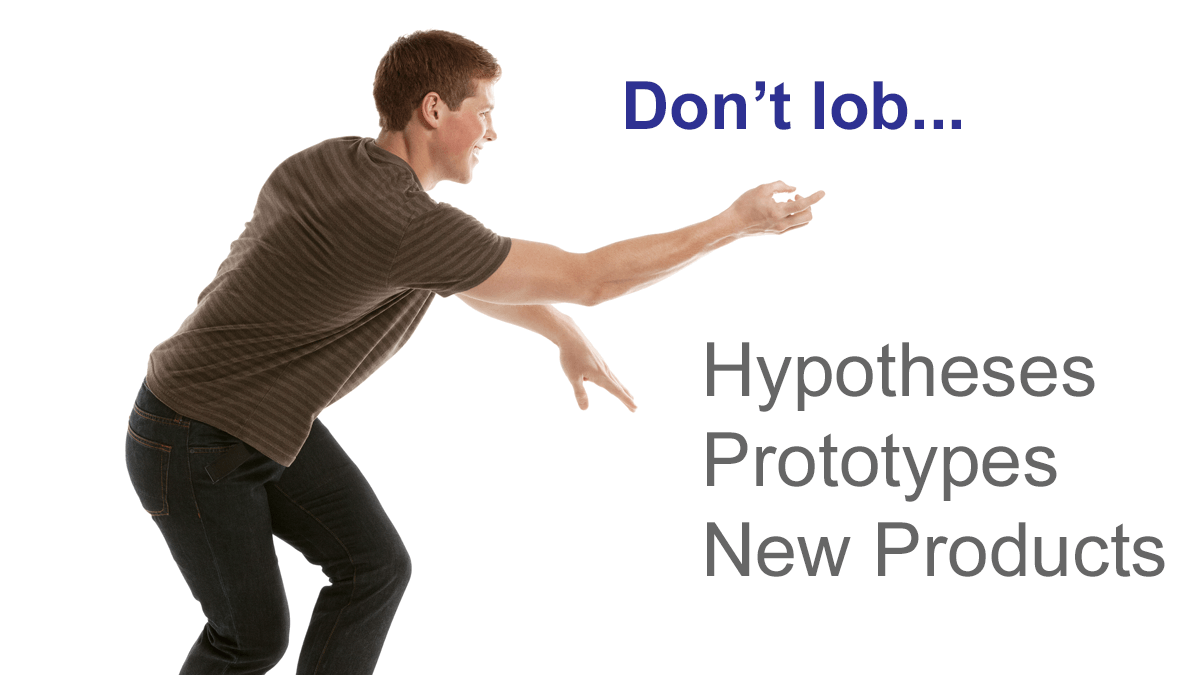During the Vietnam war, the US was still using its cold war approach of “problem as given”… applying prescribed responses for a long list of scenarios. This was a disaster in the face of evolving threats. Now their protocol is “problem as understood”… developing solutions only after the problem is well defined. Is your company using “cold-war innovation,” or does it place a high priority on learning what customers truly want before developing products for them?
More in e-book, Leader’s Guide to B2B Organic Growth
In new product development, keep your mind open to all customer needs before converging on your solutions. Your brain works better this way. It’s why we don’t “judge” ideas during brainstorming. It’s why you like digital photography better than film: You take as many shots as you like (diverge) and later pick the best (converge). When it comes to customer needs, take lots of shots so you can focus on the best later.
More in e-book, Reinventing VOC for B2B
The difference between speed and velocity is that only velocity has a direction associated with it. Many in business are focused on going as fast as they can… in any direction. Avoiding solid front-end-of-innovation work because you want to develop your new product faster is a prime example. Sure, you launched your product quickly… but no one bought it, because you failed to first understand customers’ needs.
More in e-book, Reinventing VOC for B2B
A project landmine is something that blows up budgets, schedule and reputations. No one steps on one they can see. So why don’t we look for them harder and earlier in a project life? Because we’ve been conditioned to think that killing our project equates to failure. Instead, we should identify areas of uncertainty as early as possible. Celebrate when you kill your own project swiftly… and celebrate when you try hard and are unable to kill it.
View video, De-risking Transformational Projects
Are you Newton’s object continuing in the same direction and speed… or are you the force acting on the object? Your company may think it can keep doing what it’s always done. But if your competitors learn how to understand unmet customers’ needs first, they will be the force that changes your direction (down) and speed (slower)… in their favor. Inertia is not your friend. Learning and change are.
More in e-book, Leader’s Guide to B2B Organic Growth
The Oxford Dictionary defines a factoid as an item of unreliable information that is repeated so often it becomes accepted as fact. Too often in product development, what we view as a fact is just a factoid. Its fine to have assumptions, but make sure they don’t dress up as facts. What you think you know is more dangerous than what you know you think.
View video, De-risking Transformational Projects
You’ll continue seeing innovations for how we innovate… but you should critically assess them with a “B2B filter.” Take Lean Startup. It offers some good ideas, but it can encourage you to develop and show prototypes to B2B customers before having an intelligent conversation with them. Now that’s just silly.
More in white paper, Lean Startup: Expanding the Build-Measure-Learn Cycle
There are several things you should never lob at B2B customers until you’ve first learned from them. Don’t lob your hypotheses, prototypes, or new products—until you’ve learned what these customers want. B2B customers have high knowledge, interest, objectivity and foresight… so they can tell you exactly what outcomes they want… if you know how to ask. It’s both wasteful for you and insulting to them if you assume they can’t help you.
More in Leader’s Guide Videos Lesson 12, Stop leading with your solutions
The potentially-intrusive nature of consumer “big data” has already caused some mistrust of B2C marketers. Conversely, the best B2B marketers—especially in concentrated markets with fewer customers—are now developing powerful interviewing skills to listen closely to their customers. You can imagine the response: Who among us doesn’t want to be carefully listened to and understood?
More in e-book, Leader’s Guide to B2B Organic Growth (Lesson 15)
Successful companies reap huge financial reward from bold, transformation projects. They probably approach them differently than you do today. Consider this 5-step process to safely and rationally process all the potential “landmines” that could otherwise blow up budgets, schedules, and reputations.
Learn more about project de-risking.
Don’t let the Ansoff matrix cause you to fear unfamiliar markets and technologies. Start by treating “risk” and “uncertainty” as different beasts. You’ll be bolder and more successful in driving from uncertainty to certainty when you plan with the FAQS map (Facts, Assumptions, Questions, Surprises).
More in article, Innovating in Unfamiliar Markets: How to De-risk Transformational Projects
Treat technology development and product development differently. The former is science-facing and turns money into knowledge. The latter is market-facing and turns knowledge back into money. This “separation thinking” applies to voice-of-customer: You should “test silently” any technology you have.
More in article, Should you develop new products like Steve Jobs?
A stage-and-gate process is helpful in managing the interface between your company and project teams. But by itself it leads to internal focus and a checklist mentality. Build another interface on top… between these teams and the customers they hope to satisfy. This interface is called customer insight skills.
More in article, Should Your Stage-Gate® Get a No-Go?
You’ll gain $4000 in net present value for every day you launch a typical B2B product earlier. Consider 3 ways to speed innovation: 1. Strengthen front-end work to end hesitation, second-guessing, and dead-end detours. 2. Concentrate resources on fewer projects. 3. Reduce “organizational friction.”
More in article, How Leaders Can Accelerate New-Product Innovation







